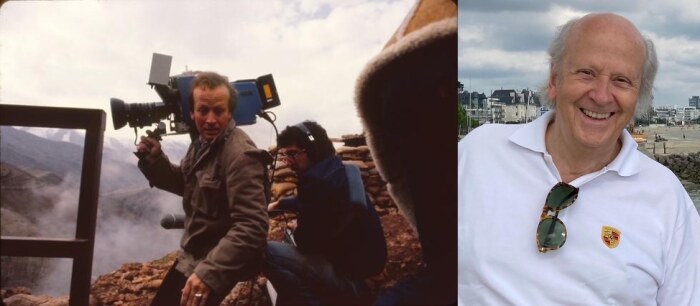Herb Strentz reviews a memoir by the French photojournalist Fabrice Moussus.
Suppose you are reading someone’s memoir or autobiography, and the author declares early on, “I have been able to pack more in my one life than several lives put together.”
That may strike you as pompous, or at best, immodest.
Those words come near the end of Grab the Moment, Fabrice Moussus’ account of how he spent the better part of three decades filming and reporting warfare and mayhem in the Middle East, Africa, Eastern Europe and elsewhere.
Far from considering the author arrogant, when you read those sixteen words on his page 174, you might think: “What took you so long to figure that out, Fabrice? That occurred to me in the first 20 pages.”
Use of the first name, Fabrice, is not token familiarity. This Frenchman was an undergrad at the University of North Dakota in the early 1970s when I chaired the Department of Journalism there. Some 50 years later, he has contributed to a post or two on Bleeding Heartland.
A photo snapshot among those at the end of Grab the Moment serves well as a metaphor of what the book offers. It is not an image of Fabrice at a war scene, nor the photo of him with the Soviet leader Mikhail Gorbachev, or of him and Barbara Walters street-dancing in Saudi Arabia — interesting as those are. It’s a picture of him engaging in one of his stress-reducing hobbies, examining a Persian rug he might buy at Baghdad market.
The book is woven together nicely like one of those good rugs. But instead of threads of fabric, the author weaves together anecdotes of camaraderie among the journalists covering the war, some insights about certain nations and the Middle East, a brief mention of U.S. mistakes there, and a short assessment of our presidents, with praise for George H.W. Bush’s Secretary of State James Baker. Fabrice’s life story offers some perspective of the bits of joy and too much pain we inflict on one another in the course of our lives.
The book’s title refers to the pressure upon the cameraman to grab the moment that will accurately capture the poignancy and drama of a news event, while at the same time keeping an eye out for what needs to be filmed next.
Moussus acknowledges that he got what in news parlance is “a break” early in his career by being the only TV cameraman on the scene when Egypt’s President Anwar Sadat was assassinated on October 6, 1981.
Producing that footage gave him credibility and a good reputation, rare for photojournalists with little experience. It helped that he lived up to high expectations of colleagues, anchors, and broadcast management.
That becomes clear as you follow his video coverage and trace his career from Egypt, Oman, Ethiopia, Yemen, The Sudan, Lebanon, East Germany, Liberia, Romania, Rwanda, Yugoslavia as it was torn into Serbia and Bosnia, Zambia, and Afghanistan.
Instances of his life-risking coverage parallel what we see now in the Ukraine, where at least four journalists have been killed during the first three weeks of the Russian invasion.
But Fabrice makes one surprising observation: “I am often asked what was the most dangerous place I have worked in. New York City in the late seventies is always my answer,” particularly in regard to drug-related stories which endangered him as did working in war zones.
The first two-thirds of Grab the Moment are primarily accounts of covering the Middle East and elsewhere, with recollections of Sadat, Gorbachev, and others. Fabrice was the go-to person when ABC anchors like Peter Jennings, Ted Koppel, Diane Sawyer, and Barbara Walters wanted video to accompany their reporting and commentary. Working for ABC, he shot the first televised footage of a U.S. bombing raid of Baghdad at the start of the Persian Gulf War in 1991.
The author also shares stories about others whom he credits with helping bring news to us. They include Dirk Vandenaker, Bill Walzer and Simon Wright, helicopter pilots in the Vietnam War, and Renato Prosper, a Portuguese veteran of the war in Angola.
Fabrice explains how he involved others in the Tanker War of 1987 in the Persian Gulf. They ferried workers back and forth from oil platforms “from point A to point B and back again. We changed all of that. We asked them to fly in circles, land on ships, get shot at and fly long hours. It was a challenge and they rose to it with enthusiasm.”
The last part of the memoir is a collection of the author’s insights about TV news coverage, ethics, his childhood, and a bit on U.S decision making in the wars he covered.
In sum, the book adds needed perspective of news coverage of violence and the pain we inflict on one another. A nice guy tells us about it.
And it’s all available for about $15 from Amazon.
Herb Strentz was dean of the Drake School of Journalism from 1975 to 1988 and professor there until retirement in 2004. He was executive secretary of the Iowa Freedom of Information Council from its founding in 1976 to 2000.
Top images: On left, Fabrice Moussus near the start of the Iraq-Iran war, filming near the Iranian village of Sushmi. On the right, a recent photo of the Grab the Moment author. Pictures provided by Herb Strentz and published with permission.

